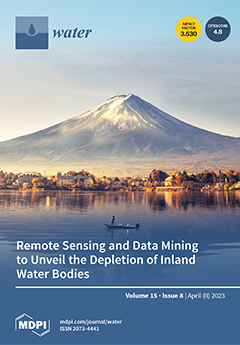In order to improve the removal efficiency of refractory organic matters in micro-polluted source water, biological manganese oxides (BMOs) were generated in situ in the biological aerated filter (BAF) (BAF 2
#), which could oxidize the refractory organic matters into biodegradable organic matters. COD
Mn and NH
4+-N in the effluent of BAF 2
# both stabilized on the 39th day, while COD
Mn and NH
4+-N in the effluent of the control BAF (BAF 1
#) stabilized on the 38th and 42nd days, respectively. In the steady phase, the removal rates of COD
Mn and NH
4+-N in BAF 1
# were 41.51% and 94.79%, respectively, while in BAF 2
#, they were 54.52% and 95.55%, respectively. BMOs generated in BAF 2
# evidently improved the efficiency of COD
Mn removal. With the increase in the influent Mn
2+ in BAF 2
#, the rate of COD
Mn removal was gradually improved to 63.60%, while the efficiency of NH
4+-N removal was slightly improved, COD
Mn was evidently removed in each section of the filter layer, and ammonia was mainly removed in the 0~0.8 m layer of the filter. COD
Mn was evidently removed in each section of the filter layer, and NH
4+-N was mainly removed in the 0~0.8 m layers of the filter. Biological COD
Mn, Mn
2+, and NH
4+-N removal all followed the first-order kinetic reaction. As the influent Mn
2+ gradually increased from 0 to about 0.5, 1, and 2 mg/L, the efficiency of COD
Mn removal along the filter layer was significantly improved, but the efficiency of NH
4+-N removal was slightly improved. The kinetic constant
k of biological COD
Mn removal significantly increased, while the kinetic constant
k of biological Mn
2+ and NH
4+-N removal gradually increased.
Full article





